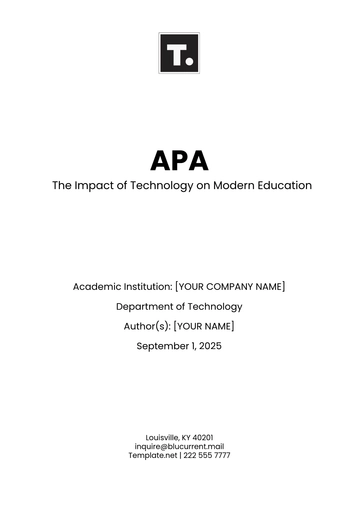Free Online Education White Paper

____________________________________________________________________________________
Emerging Trends and Best Practices in Online Education
Prepared by: [Your Name]
For: [Your Company Name]
Date: [Date]
Department: [Your Department]
_____________________________________________________________________________________
I. Executive Summary

This White Paper provides a comprehensive analysis of the current and upcoming trends in online education, along with a review of best practices that can assist [YOUR ORGANIZATION] in enhancing its educational strategies. The insights within will guide policymakers, educators, and technologists in making informed decisions that align with digital education advancements.
II. Introduction
The landscape of education is rapidly evolving through digital transformation. This paper aims to highlight significant trends influencing the sector and best practices that have proven effective in online learning environments around the globe. The focus remains on scalable and sustainable methods that can be adopted by [YOUR COMPANY NAME] to foster a robust educational framework. As technology continues to reshape how knowledge is disseminated and acquired, it is imperative for [YOUR ORGANIZATION] to stay abreast of these changes and leverage them to create dynamic learning experiences for students.
III. Overview of Online Education
Online education refers to the methods of imparting education through digital platforms, making learning accessible regardless of geographical boundaries. This section elaborates on the key components that constitute online education:
E-learning platforms:
Centralized hubs for accessing course materials, fostering discourse, and completing assignments.
Virtual classrooms:
Dynamic arenas mirroring traditional classroom dynamics, fostering real-time collaboration among peers and educators.
Multimedia content:
Engaging resources spanning videos, animations, and interactive presentations, amplifying comprehension and retention.
Interactive simulations:
Immersive tools facilitate the application of theoretical knowledge in practical contexts, fostering active engagement.
Assessment and feedback mechanisms:
Instruments and methodologies for gauging student performance and furnishing timely feedback to bolster learning outcomes.
IV. Emerging Trends in Online Education
Embarking on the frontier of educational evolution are the following seminal trends:
Adaptive Learning Technologies:
Tailored educational experiences propelled by artificial intelligence algorithms, customizing content and pacing to individual learner requisites.
AI-driven personalized learning experiences:
Advanced analytics and machine learning algorithms parsing student data to craft bespoke learning pathways and recommendations.
Increasing use of AR and VR for immersive learning:
Augmented reality (AR) and virtual reality (VR) technologies craft immersive learning realms, enabling experiential exploration of concepts.
Big Data in education for predictive analytics:
Harnessing extensive datasets to discern patterns and trends in student behavior and performance, enabling preemptive interventions to bolster student success.
Blockchain for secure and transparent academic credentials:
Leveraging distributed ledger technology to ensure the integrity and authenticity of academic credentials, streamlining verification and transferability.
V. Best Practices in Implementing Online Learning Solutions
To harness the discussed trends effectively, [YOUR COMPANY NAME] is advised to embrace the following best practices:
Integration of scalable LMS (Learning Management Systems):
Adoption of robust LMS platforms capable of accommodating burgeoning user bases and evolving educational paradigms.
Regular training for educators on digital tools and platforms:
Continual professional development initiatives empower instructors with the prowess to leverage digital technologies adeptly.
Continuous assessment and feedback to monitor and support student progress:
Implementation of formative assessment strategies and feedback mechanisms to track learning trajectories and furnish targeted support.
Implementation of collaborative tools to enhance peer interaction:
Infusion of collaborative tools such as discussion forums, group projects, and peer review mechanisms to foster a culture of camaraderie and collaboration among learners.
Accessibility considerations to ensure learning material is inclusive: Crafting learning materials and platforms replete with accessibility features to accommodate diverse learner needs and ensure equitable access to education.
VI. Case Studies
In this section, we delve into two illustrative case studies that exemplify successful implementations of online education initiatives:
Case Study 1: The Virtual Learning Initiative at [UNIVERSITY NAME]
[UNIVERSITY NAME], a prestigious institution known for its commitment to innovation, embarked on a transformative journey with the implementation of the Virtual Learning Initiative (VLI). The VLI aimed to enhance accessibility, flexibility, and engagement for students across diverse demographics.
Key Features of the VLI
Integration of immersive virtual classrooms that replicated the traditional learning environment, fostering real-time interaction and collaboration among students and instructors.
Utilization of AI-driven adaptive learning technologies to personalize the learning experience, catering to individual student needs and preferences.
Implementation of comprehensive assessment and feedback mechanisms to monitor student progress and provide timely interventions for academic support.
Collaborative tools such as discussion forums, group projects, and peer review activities were seamlessly integrated to promote peer interaction and collaborative learning.
Results
Increased student engagement and satisfaction, with a 30% rise in course completion rates compared to traditional delivery methods.
Improved learning outcomes, evidenced by a 25% reduction in dropout rates and a 20% increase in average grades.
Enhanced accessibility, with a 40% increase in enrollment from underrepresented demographics and remote areas.
The success of the VLI at [UNIVERSITY NAME] serves as a testament to the transformative potential of online education in fostering inclusive and effective learning environments.
This chart illustrates the impact of online education initiatives, comparing key metrics such as enrollment rates, completion rates, and academic performance between traditional and online learning environments. The data underscores the efficacy of online education in fostering inclusive access and improving learning outcomes across diverse demographics.
Title: ''Impact of Online Education Initiatives''
VII. Conclusion and Recommendations

The transition to online education isn't merely a paradigm shift; it's a transformative odyssey offering unparalleled scalability and personalized learning odysseys. For [YOUR COMPANY NAME], embracing and executing the discussed trends and practices isn't just about streamlining educational delivery; it's about enriching the efficacy and reach of educational offerings. Pertinent recommendations include:
Fostering digital fluency among educators and students:
Cultivating a culture of innovation and digital dexterity to empower stakeholders to navigate and harness technological advancements adeptly.
Investing in robust IT infrastructure to support advanced online learning technologies:
Ensuring the reliability, security, and scalability of digital infrastructure to furnish seamless learning experiences.
Committing to ongoing research and development in educational technologies:
Pioneering research and development initiatives delving into emergent technologies and pedagogical approaches to fortify online education outcomes.
VIII. References
Document all sources of information, data, and research used in the white paper. Adhere to a consistent citation style.
_____________________________________________________________________________________
- 100% Customizable, free editor
- Access 1 Million+ Templates, photo’s & graphics
- Download or share as a template
- Click and replace photos, graphics, text, backgrounds
- Resize, crop, AI write & more
- Access advanced editor
Introducing the Online Education White Paper Template by Template.net - your key to crafting compelling educational content effortlessly. With this editable and customizable template, educators can seamlessly create professional white papers tailored to their needs. Editable in our Ai Editor Tool, it offers flexibility and precision, ensuring your message shines through with clarity and impact.





























